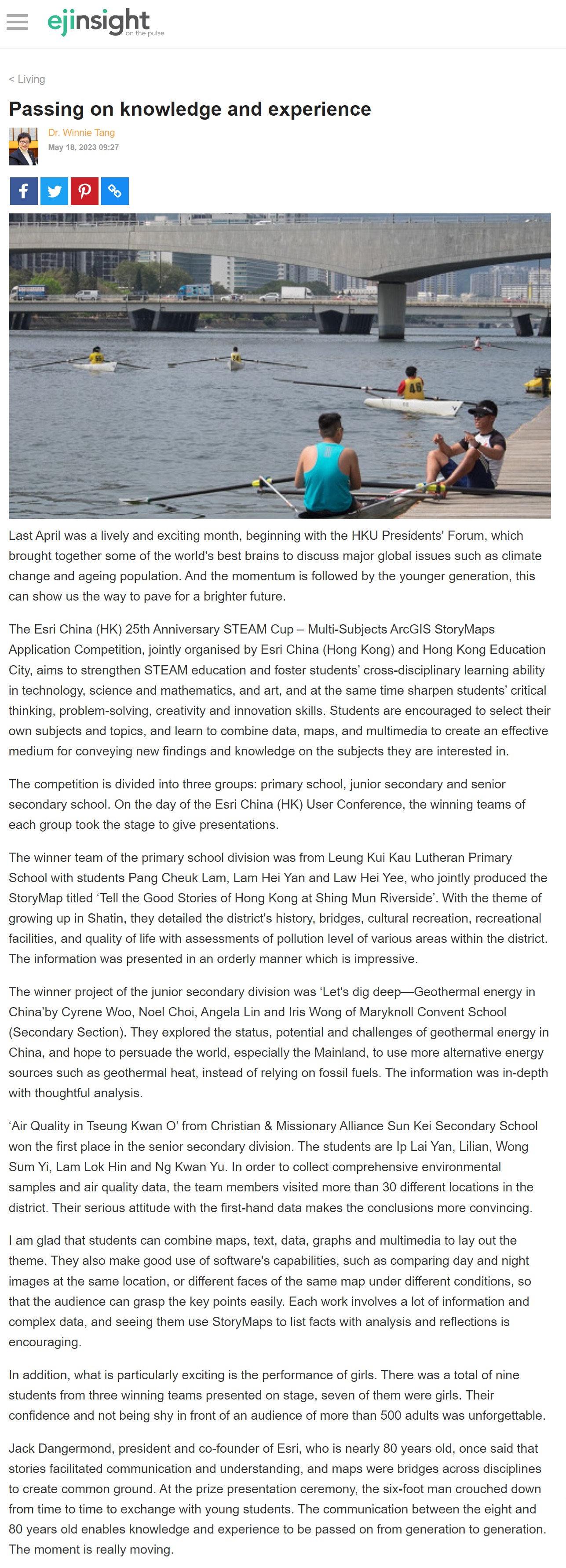網上版請按此

Passing on knowledge and experience
Last April was a lively and exciting month, beginning with the HKU Presidents' Forum, which brought together some of the world's best brains to discuss major global issues such as climate change and ageing population. And the momentum is followed by the younger generation, this can show us the way to pave for a brighter future.
The Esri China (HK) 25th Anniversary STEAM Cup – Multi-Subjects ArcGIS StoryMaps Application Competition, jointly organised by Esri China (Hong Kong) and Hong Kong Education City, aims to strengthen STEAM education and foster students' cross-disciplinary learning ability in technology, science and mathematics, and art, and at the same time sharpen students' critical thinking, problem-solving, creativity and innovation skills. Students are encouraged to select their own subjects and topics, and learn to combine data, maps, and multimedia to create an effective medium for conveying new findings and knowledge on the subjects they are interested in.
The competition is divided into three groups: primary school, junior secondary and senior secondary school. On the day of the Esri China (HK) User Conference, the winning teams of each group took the stage to give presentations.
The winner team of the primary school division was from Leung Kui Kau Lutheran Primary School with students Pang Cheuk Lam, Lam Hei Yan and Law Hei Yee, who jointly produced the StoryMap titled 'Tell the Good Stories of Hong Kong at Shing Mun Riverside'. With the theme of growing up in Shatin, they detailed the district's history, bridges, cultural recreation, recreational facilities, and quality of life with assessments of pollution level of various areas within the district. The information was presented in an orderly manner which is impressive.
The winner project of the junior secondary division was 'Let's dig deep—Geothermal energy in China'by Cyrene Woo, Noel Choi, Angela Lin and Iris Wong of Maryknoll Convent School (Secondary Section). They explored the status, potential and challenges of geothermal energy in China, and hope to persuade the world, especially the Mainland, to use more alternative energy sources such as geothermal heat, instead of relying on fossil fuels. The information was in-depth with thoughtful analysis.
'Air Quality in Tseung Kwan O' from Christian & Missionary Alliance Sun Kei Secondary School won the first place in the senior secondary division. The students are Ip Lai Yan, Lilian, Wong Sum Yi, Lam Lok Hin and Ng Kwan Yu. In order to collect comprehensive environmental samples and air quality data, the team members visited more than 30 different locations in the district. Their serious attitude with the first-hand data makes the conclusions more convincing.
I am glad that students can combine maps, text, data, graphs and multimedia to lay out the theme. They also make good use of software's capabilities, such as comparing day and night images at the same location, or different faces of the same map under different conditions, so that the audience can grasp the key points easily. Each work involves a lot of information and complex data, and seeing them use StoryMaps to list facts with analysis and reflections is encouraging.
In addition, what is particularly exciting is the performance of girls. There was a total of nine students from three winning teams presented on stage, seven of them were girls. Their confidence and not being shy in front of an audience of more than 500 adults was unforgettable.
Jack Dangermond, president and co-founder of Esri, who is nearly 80 years old, once said that stories facilitated communication and understanding, and maps were bridges across disciplines to create common ground. At the prize presentation ceremony, the six-foot man crouched down from time to time to exchange with young students. The communication between the eight and 80 years old enables knowledge and experience to be passed on from generation to generation. The moment is really moving.
Dr. Winnie Tang
Adjunct Professor, Department of Computer Science, Faculty of Engineering; Department of Geography, Faculty of Social Sciences; and Faculty of Architecture, The University of Hong Kong